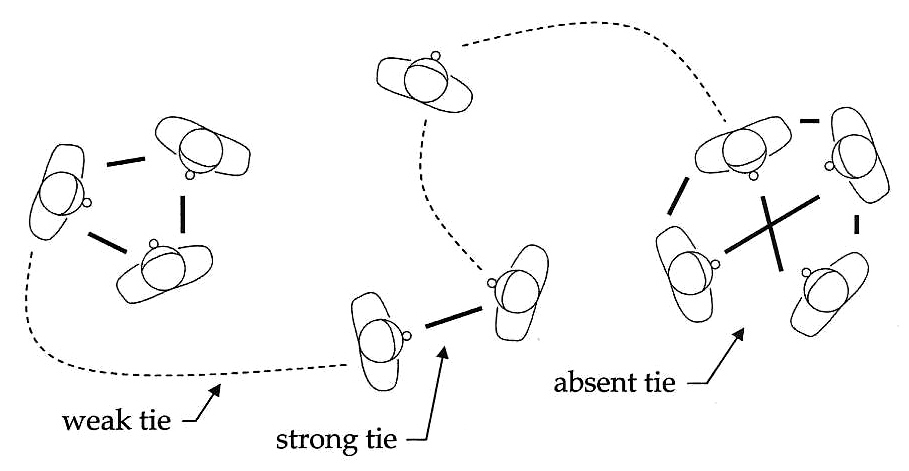Remote work highlights the value of weak ties
Something we can expect to hear a lot about in the near future is the power of weak ties. It’s a well-established idea in sociology, anthropology, and social network analysis theory. But it’s about to be invigorated as a way of thinking about workplaces and working culture in the wake of two major peer-reviewed studies into the effects of remote work on people and the way they work with each other.
According to the most widely cited paper on the subject of relationships, Mark Granovetter’s The Power of Weak Ties, the relationships between people can be categorised as strong, weak or absent. The latter is self-explanatory. Strong ties exist between people who are related, friend or who interact on a day to day basis.
Weak ties exist between people who know each, but not well, maybe interacting now and then, often by chance. The paper goes on to discuss how the relationships that exist in networks are dependent on a combination of weak and strong ties to provide people with information. The absence of weak ties can exclude people from knowing things that may be useful to them. It is weak ties that allow information to flow between groups of people with strong ties to each other.
This hypothesis is borne out by two large scale studies of the effects of remote work on the output and creativity of major tech organisations.
The first, a study of 61,000 Microsoft employees led by researchers from the MIT Sloan School of Management, found that while short term productivity stayed the same or increased for the majority of people, it came at the cost of lower levels of innovation and extended project completion times.
The reason for this, according to the study, is that remote workers spent less time in meetings, had fewer real time conversations and worked in more siloed ways, effectively bypassing their weak ties, preventing them from addressing absent ties and focussing instead on their strong ties. It concluded that the side-lining of weak ties held people from producing their best work and had a negative impact on working culture.
Remote work caused the share of collaboration time employees spent with cross-group connections to drop by about 25 percent of the pre-pandemic level.
Furthermore, firm-wide remote working caused separate groups to become more ‘intraconnected’ by adding more connections within themselves. The shift to remote work also caused the organisational structure at Microsoft to become less dynamic; Microsoft employees added fewer new collaborators and shed fewer existing ones.
“Microsoft employees didn’t just change who they worked with, but also how they worked with them,” the authors say. “The results indicate that the shift to firm-wide remote work increased unscheduled call hours but decreased total meetings and call hours by 5 percent of their pre-pandemic level. This suggests that the increase in meetings many experienced during the pandemic was not due to remote work, but due to the pandemic and related factors.
The paper’s conclusions mirror those of another recent analysis of the effect of remote work led by Ben Waber and Zanele Munyikwa and written up in the Harvard Business Review under the headline Did WFH Hurt the Video Game Industry? The answer to their question is yes with many developers seeing falls in creativity and productivity, longer project times and delayed launches.
The authors found that while people tended to communicate more with their strong ties while working remotely, they missed out on the formation and benefits of weak ties. “In general”, they write, “employees appear to have effectively collaborated intentionally, but organizations have faltered at creating an environment where important serendipitous collaboration can flourish. The default mode of collaboration — both processes and tools — when people work remotely seems to impede the creation of new weak ties and the maintenance of old ones. Most individual awareness is rightly centered on near-term results but it’s much harder to push weak ties into conscious awareness. The long-term positive effects of weak ties can take months, or years, to become apparent.”
The upshot is that organisations may not know there is a problem with their working culture for a long time, possibly until it’s too late because short-term measures of productivity blind them to the cracks developing under the surface.
As the authors of both reports conclude, this is something we will have to be aware of as we plan the way ahead for work and workplaces. The success of the organisation and our personal creativity and productivity don’t just depend on relationships with people in our inner circle, but also with those who pop their heads into it, now and then.
The subjects of collaboration and the vital role of the office is explored in detail in the latest issue of Sedus Insights

